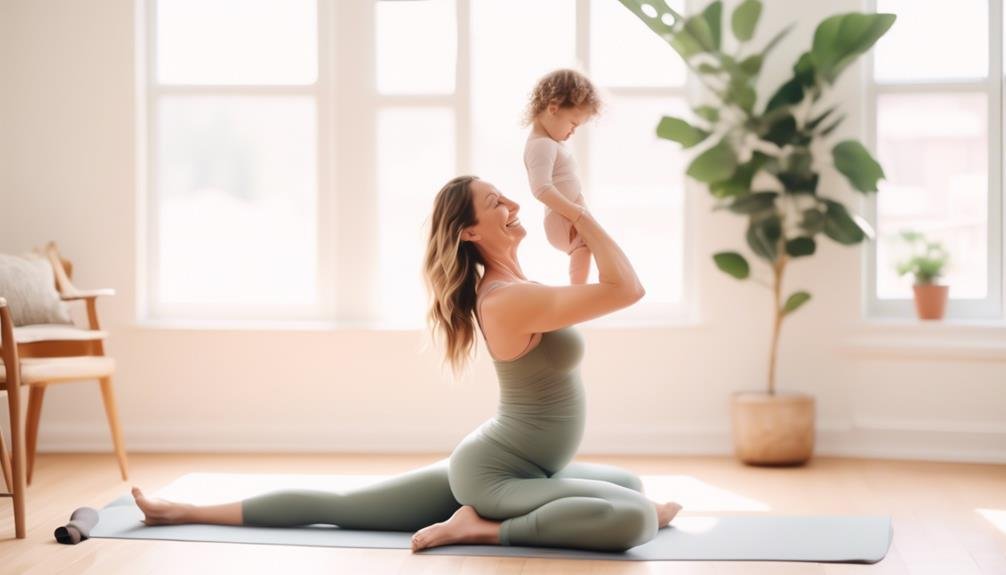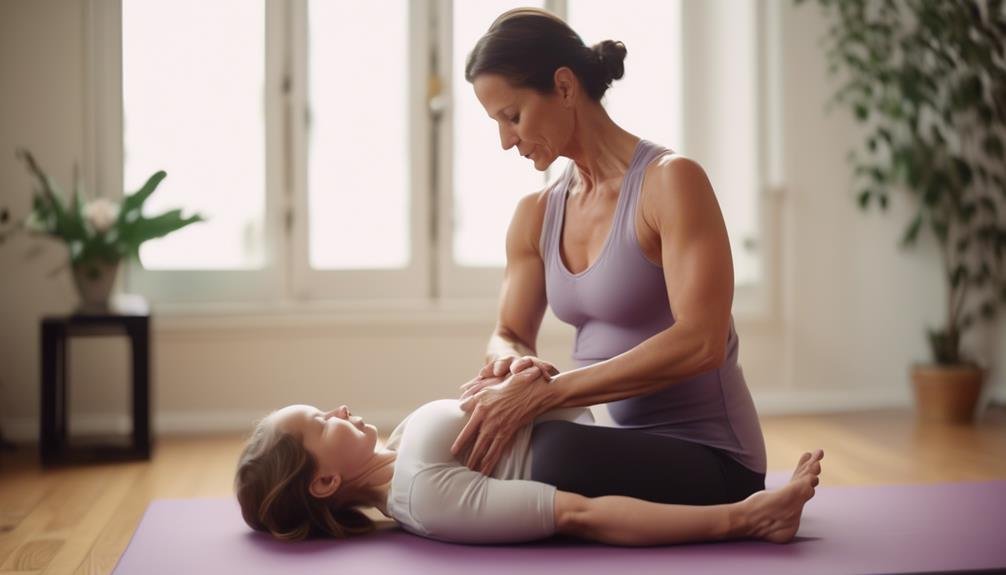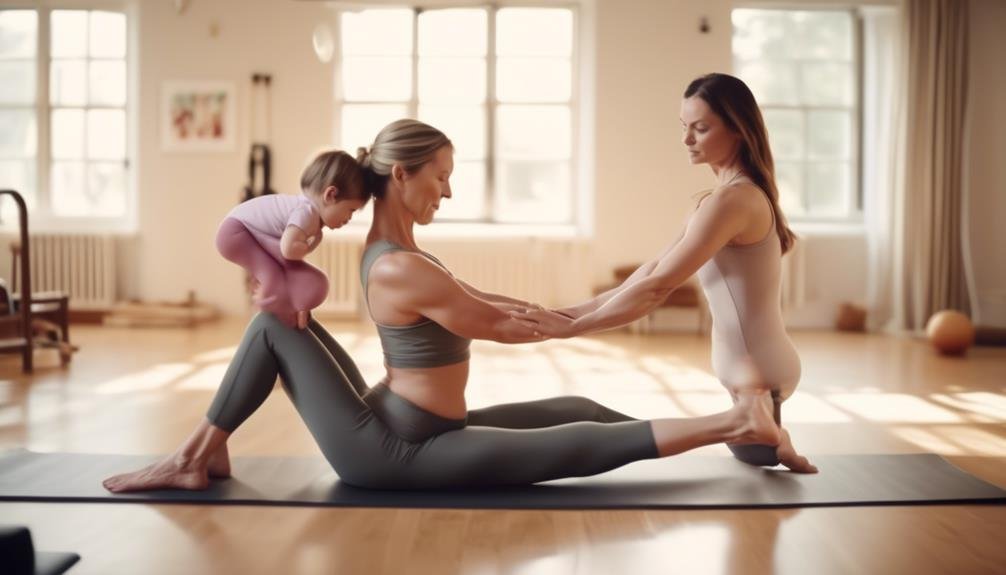"Cherishing Little Steps - A Haven for Baby and Family Journeys"
Postnatal Pilates for Strength
Imagine yourself standing tall and strong, feeling the gentle breeze against your skin as you hold your baby in your arms. As a new mom, your body has gone through incredible changes, and now you're ready to regain your strength.
Postnatal Pilates can be the key to rebuilding your core, improving your posture, and increasing your overall strength. But where do you start? How can you safely and effectively use Pilates to strengthen your body after childbirth?
In this discussion, we will explore the benefits of Postnatal Pilates and provide you with essential exercises to help you on your journey towards a stronger, healthier you. Get ready to discover the transformative power of Postnatal Pilates and unlock your full potential.
Key Takeaways
- Postnatal Pilates targets deep core muscles for improved strength, helping new mothers regain their strength and tone their bodies after giving birth.
- It provides a safe and supportive environment, where new mothers can exercise with guidance from trained instructors and prevent potential injuries.
- Postnatal Pilates helps improve posture and alleviate back pain, which are common concerns for new mothers.
- Engaging in postnatal Pilates promotes community and understanding among new mothers, creating a supportive network of individuals going through similar experiences.
The Benefits of Postnatal Pilates

Postnatal Pilates offers numerous benefits that can help you regain strength, improve posture, and promote overall well-being after giving birth. As a new mother, you may face various challenges, both physical and emotional. Postnatal Pilates can be a valuable tool to overcome these challenges and support your postpartum recovery journey.
One of the significant benefits of postnatal Pilates is that it targets the deep core muscles, which are essential for stabilizing your body and improving your overall strength. By strengthening these muscles, you can regain your pre-pregnancy strength and support your body as it adjusts to the physical demands of motherhood.
Additionally, postnatal Pilates focuses on improving your posture. During pregnancy, your body undergoes significant changes, which can often lead to poor posture and back pain. By practicing Pilates, you can develop better body awareness, align your spine, and alleviate discomfort.
Moreover, postnatal Pilates provides a safe and supportive environment. It allows you to connect with other new mothers who may be facing similar challenges, creating a sense of community and understanding. The instructor's guidance and expertise ensure that you perform exercises correctly, preventing any potential injuries and maximizing the benefits.
Getting Started With Postnatal Pilates

Now that you understand the benefits of postnatal Pilates, it's time to take the first step towards getting started on your postpartum recovery journey. Congratulations on making this commitment to your health and well-being! To help you get started, here are some recommendations and tips:
- Postnatal Pilates Equipment Recommendations:
- Mat: A good-quality, non-slip mat will provide cushioning and support during your workouts.
- Resistance Bands: These versatile bands will help you strengthen and tone your muscles without putting excessive strain on your body.
- Pilates Ball: Using a Pilates ball can enhance your workouts by adding resistance and stability challenges.
Finding Postnatal Pilates Classes Near You:
- Online Resources: Many instructors offer virtual classes that you can join from the comfort of your own home. Look for reputable websites or apps that provide postnatal Pilates programs.
- Local Studios: Check with Pilates studios in your area to see if they offer postnatal-specific classes. These classes are designed to cater to the needs of new moms and provide a supportive environment.
Essential Pilates Exercises for New Moms

To effectively strengthen and tone your postpartum body, incorporating essential Pilates exercises into your fitness routine is key. Pilates is a gentle yet effective form of exercise that can help you regain strength, improve posture, and promote overall well-being after childbirth. Two specific areas that new moms often focus on are the pelvic floor and diastasis recti.
The pelvic floor is a group of muscles that support the bladder, uterus, and bowel. During pregnancy and childbirth, these muscles can become weakened. Strengthening the pelvic floor is crucial for preventing issues such as urinary incontinence and pelvic organ prolapse. Incorporating exercises like Kegels and pelvic tilts into your Pilates routine can help restore strength and function to these muscles.
Diastasis recti is a separation of the abdominal muscles that can occur during pregnancy. Pilates exercises that target the deep core muscles, such as the transverse abdominis, can help close the gap and improve abdominal strength and stability. It's important to avoid exercises that put excessive strain on the abdominal muscles, such as traditional sit-ups, until the separation has healed.
Here are some essential Pilates exercises for new moms:
| Exercise | Benefits |
|---|---|
| Pelvic tilts | Strengthens the pelvic floor and helps improve posture |
| Kegels | Restores strength and function to the pelvic floor muscles |
| Transverse abdominis activation | Closes the gap in diastasis recti and improves core stability |
Remember to consult with your healthcare provider before starting any new exercise routine, especially if you have any postpartum complications. With consistency and patience, Pilates can be a valuable tool in your postpartum journey, helping you regain strength and confidence in your body.
Strengthening the Core With Postnatal Pilates
Strengthen your core and regain postpartum strength with the power of Postnatal Pilates. This form of exercise isn't only effective but also safe for new moms like you. By focusing on strengthening the core, Postnatal Pilates can help you rebuild your abdominal muscles and improve overall stability.
Here are three key benefits of incorporating Postnatal Pilates into your fitness routine:
- Strengthening the pelvic floor: After giving birth, the pelvic floor muscles can become weakened. Postnatal Pilates exercises specifically target these muscles, helping to improve their strength and function. This can address issues such as urinary incontinence and provide better support for your pelvic organs.
- Maintaining abdominal separation: During pregnancy, the abdominal muscles can separate in order to accommodate the growing baby. This condition, known as diastasis recti, can persist postpartum. Postnatal Pilates includes exercises that focus on closing the gap between the abdominal muscles, promoting healing and restoring core strength.
- Improving overall core stability: Postnatal Pilates targets not only the superficial abdominal muscles but also the deep core muscles. By engaging these deeper muscles, you can improve your overall core stability, which is essential for everyday activities and for preventing future injuries.
Toning and Sculpting With Postnatal Pilates

Get ready to sculpt and tone your postnatal body with the incredible power of Postnatal Pilates. After pregnancy, many women desire to regain their pre-baby shape and feel confident in their own skin. With a specialized postnatal fitness program like Pilates, you can achieve your goals and more.
Postnatal Pilates is an effective way to tone and sculpt your body after pregnancy. It focuses on strengthening and lengthening the muscles, improving flexibility, and restoring balance and alignment. By engaging the core and targeting specific muscle groups, you can reshape your body and achieve a toned and sculpted physique.
To give you an idea of the benefits of Postnatal Pilates, take a look at the table below:
| Benefits of Postnatal Pilates | ||||
|---|---|---|---|---|
| Tones and sculpts muscles | Improves flexibility | Restores core strength | Enhances body posture | Promotes overall fitness |
Postnatal Pilates for Improved Posture

After sculpting and toning your postnatal body with Postnatal Pilates, the next step is to focus on improving your posture. Proper posture is essential not only for looking confident and poised but also for preventing back pain.
By incorporating specific exercises into your Postnatal Pilates routine, you can strengthen the muscles that support your spine, leading to better alignment and decreased discomfort. Here are three key ways in which Postnatal Pilates can help improve your posture:
- Core strengthening: Postnatal Pilates targets the deep abdominal muscles that are crucial for maintaining good posture. By strengthening your core, you create a strong foundation for your spine and pelvis, improving your overall posture.
- Upper back mobility: Postnatal Pilates exercises often involve movements that promote flexibility and mobility in the upper back. This helps to counteract the hunched posture that can occur from breastfeeding or carrying your little one, relieving tension and promoting better alignment.
- Shoulder stabilization: Postnatal Pilates focuses on strengthening the muscles around your shoulders, which can help prevent rounded shoulders and promote a more upright posture. This is especially important for new moms who may spend long hours nursing or carrying their baby.
Increasing Flexibility Through Postnatal Pilates
Improve your flexibility and enhance your postnatal Pilates practice through targeted exercises that promote mobility and range of motion. Increasing flexibility isn't only beneficial for your physical health, but it can also support your overall well-being. By incorporating specific techniques into your postnatal Pilates routine, you can improve balance, prevent injuries, and feel more confident in your body.
To improve flexibility, focus on stretching exercises that target different muscle groups. Incorporate movements that gently lengthen your muscles, such as side stretches, hamstring stretches, and spinal twists. These exercises won't only increase your flexibility but also help prevent muscle imbalances and reduce the risk of injuries.
Balance is another important aspect of flexibility. By working on your balance through targeted exercises, you can improve your stability and coordination. Try incorporating standing exercises, such as single-leg balances or heel-to-toe walks, into your postnatal Pilates routine. These exercises won't only challenge your balance but also engage your core muscles, helping to strengthen your abdominal muscles and improve your posture.
Remember to always listen to your body and modify exercises as needed. As you progress in your postnatal Pilates practice, you'll notice improvements in your flexibility, balance, and overall strength. Celebrate your achievements and enjoy the journey towards a more flexible and resilient body.
Combining Cardio and Strength With Postnatal Pilates

As you continue your postnatal Pilates journey, you can further enhance your workout by incorporating cardio and strength exercises. By adding these elements, you'll not only increase your cardiovascular fitness but also boost your weight loss efforts.
Here are some ways to combine cardio and strength with your postnatal Pilates routine:
- Circuit Training: Create a circuit that alternates between Pilates exercises and cardio movements such as jumping jacks or high knees. This will keep your heart rate up while engaging different muscle groups.
- Interval Training: Incorporate intervals of high-intensity cardio bursts into your Pilates routine. For example, perform a set of squats or lunges followed by a minute of jumping rope. This combination will challenge your muscles and keep your heart rate elevated.
- Cardio Pilates Classes: Join a specialized class that combines Pilates movements with cardiovascular exercises. These classes often incorporate equipment like resistance bands or weights to add an extra challenge to your workout.
Progressing Your Postnatal Pilates Routine

To continue challenging yourself and achieving progress in your postnatal Pilates routine, it's important to incorporate new exercises and variations that target different muscle groups. As your body continues to recover from pregnancy and childbirth, you can gradually increase the intensity and difficulty of your workouts.
One way to do this is by progressing modifications of the exercises you have already been doing. For example, if you have been doing modified push-ups on your knees, you can start doing them on your toes to engage your core and upper body even more.
In addition to progressing modifications, incorporating props into your postnatal Pilates routine can add variety and challenge. Props such as resistance bands, Pilates balls, and foam rollers can help you target specific muscle groups and increase the resistance of your exercises. For example, using a resistance band during squats can engage your glutes and thighs more effectively.
Remember to listen to your body and progress at your own pace. It's normal to feel some muscle soreness after trying new exercises or increasing the intensity. However, if you experience any pain or discomfort, it's important to modify or stop the exercise and consult with a healthcare professional.
Staying Motivated on Your Postnatal Pilates Journey

Stay motivated on your postnatal Pilates journey by setting achievable goals and celebrating your progress along the way. It's important to stay focused and motivated as you work towards regaining your strength and fitness after giving birth.
Here are some tips to help you stay on track:
- Set realistic goals: Start by setting small, achievable goals that you can work towards. This could be improving your core strength, increasing your flexibility, or mastering specific Pilates exercises. By setting realistic goals, you'll be more likely to stay motivated and see progress.
- Track your progress: Keep a journal or use a fitness app to track your progress. This won't only help you stay accountable, but also allow you to see how far you've come. Celebrate each milestone and use it as motivation to keep going.
- Find a support system: Surround yourself with like-minded individuals who can offer support and encouragement. This could be joining a postnatal Pilates class or finding a workout buddy. Having a support system can help keep you motivated and accountable.
Frequently Asked Questions
Are There Any Age Restrictions for Postnatal Pilates?
There aren't any age restrictions for postnatal Pilates. It's a great way for older mothers to regain strength and flexibility. During pregnancy, modifications can be made to ensure a safe and effective workout.
How Soon After Giving Birth Can I Start Doing Postnatal Pilates?
You can start doing postnatal Pilates as soon as your doctor gives you the green light. It's a great way to regain strength and tone your body after giving birth. The exercises specifically target your core muscles and help with postpartum recovery.
Can I Do Postnatal Pilates if I Had a C-Section?
You can do postnatal Pilates even if you had a c-section. Just make sure to listen to your body and consult with your doctor for a recovery timeline. Modifications may be needed for certain exercises. You got this!
Will Postnatal Pilates Help With Diastasis Recti?
Postnatal pilates can indeed help with diastasis recti, a common condition after pregnancy. It strengthens your core muscles and improves overall strength. Recommended exercises include pelvic tilts, heel slides, and abdominal bracing. You got this!
Can Postnatal Pilates Help With Postpartum Depression?
Postnatal pilates can have a positive impact on your mood and emotional well-being. It offers benefits for postpartum depression by promoting relaxation, reducing stress, and boosting self-confidence. Give it a try and nurture your emotional health!
Conclusion
Congratulations, new mom! You've embarked on a journey of strength, flexibility, and self-care with postnatal Pilates.
By incorporating these essential exercises into your routine, you'll not only strengthen your core but also tone and sculpt your body.
With the added benefits of increased flexibility and the option to combine cardio and strength training, Pilates has everything you need to feel empowered and confident in your postnatal journey.
So keep going, stay motivated, and enjoy the incredible results you'll achieve! You've got this, mama!


